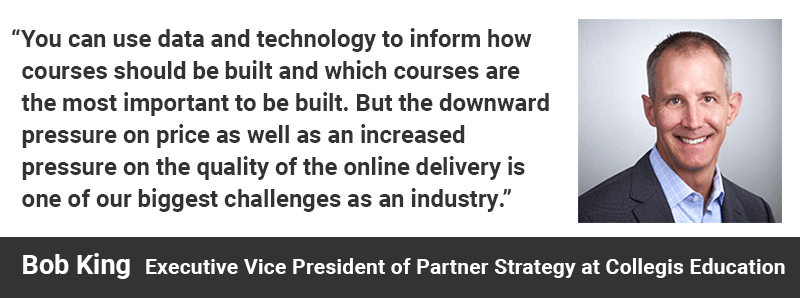The Urgent Need for Online Instruction—
and the Future of Campus Tech
By Kelli Anderson

Bob King has a message for higher ed: Get ready for a blended, hybrid, technology-enabled and student-centric future. King is the Executive Vice President of Partner Strategy at Collegis Education, a leading provider of technology-embedded managed services for higher education. “Technology will be a game changer in higher ed,” he says. “ Student expectations have already been set by the leading edge companies in Silicon Valley like Apple, Google and Netflix. The reality is most institutions need to catch up to deliver the experience students are seeking and expect.”
The gauntlet of challenges facing higher ed includes, of course, the global pandemic that sent educators scrambling to figure out how to teach classes from home offices, kitchen tables, basements and closets. King also points to pre-COVID-19 stressors that range from a shrinking college-age population to a burgeoning need to streamline business processes and meet the technology expectations of a generation raised on Instagram and Venmo. But where others see pressures, King sees possibilities. “We have numerous opportunities to apply technology to improve student experience, improve student retention,” he says.
I recently spoke with King about the future of technology in higher ed, today’s urgent need for online instruction—and the three things every school needs to do right now to prepare for the next decade. He also shared insights into what he calls, the “million dollar question,” exploring how college administrators can balance downward pressures on price with the need to invest in quality digital infrastructure and ecosystems.
Q. How is the pandemic accelerating changes in higher ed, and what are your clients focusing on?
King: Schools that are not in online education in any meaningful way today are aggressively trying to figure out how to get there. A lot of traditional residential schools patch-worked their way through spring with synchronous Zoom classes. And that’s pushed them to think about more traditional asynchronous online education and look into creating or licensing content. We’re also seeing a lot of requests from clients about applying technology in the area of student engagement—from recruiting, admissions and enrollment to managing summer melt.

Q. How will technology play a role in the rapid evolution of higher education?
King: We have been a laggard industry when you look at the way many fields use technology to improve customer acquisition and retention. Take enrollment. When a prospective student fills out an inquiry form on the website, the inquiry comes to the CRM and then what happens next? An admissions representative picks up the phone to call that student. Do 18-year-old kids want to talk on the phone? I think there's a broad need for schools to pay attention to where students are and what platforms they are using, whether it’s Snapchat or TikTok or something else.
Gen Z and late-stage millennials are used to a much more sophisticated technology infrastructure and ecosystem than what they’ll get at many colleges. The idea that you don't have a single sign-on—or that you don't have a very sophisticated student portal, LMS or application process—won’t appeal to them. We're seeing a lot of schools interested in using technology as a way to streamline processes and to provide a better environment for prospective and current students.
We’re not used to thinking of students as customers. But this is a very competitive market now; to survive and thrive in it, you can't just wait for the students to come to you. You need to build attractive academic programs and update those programs, build personalized marketing and enrollment strategies that connect with students where they are—because they've got a lot of choices.
Q. In what other ways are students’ needs and expectations evolving?
King: I think there's a massive change that started a few years ago that COVID-19 is only accelerating. From a programmatic perspective, we are shifting towards a skills economy. A lot of partners are looking at what I'll call hybrid programs. For example, if you get a graphic design degree but you also have some coding classes that were part of that degree, it makes you far more employable. We've seen that across the board. There’s some fantastic Burning Glass data on the benefit of hybrid programs. Program selection is becoming far more important to students, as are modality and price.
Industry Insights from Collegis Education
- Report: Pricing Strategies in a Post-COVID-19 World
- Infographic: 8 Stages of the College Decision Process
- Webinar: Effective Leadership During a Crisis
- Webinar: The Need for Digital Transformation
- Blog post: Economics of an OPM vs. an Unbundled OPE—The Financial Impacts of Partnership for Online Programs
- Blog for Higher Ed Leaders
Q. What do you think higher education will look like in the future?
King: Some people think it's going to be the mega universities and that's it. Others think it's going to mostly stay as it has always been. I think some schools will maintain their niche as being predominantly residential, but a lot of schools will need to adopt online one way or another.
When I say ‘adopt online,’ I don’t mean they need to become an online school. We have some partners with very modest growth goals that are adding online classes simply because they believe it's what students want. They're not moving away from their mission of being a residential school or from the program areas they're focusing on, but they're looking at Gen Z and saying, ‘These students probably want more of a blended experience.’
What does blended mean? Does it mean that the students today can take their class in the classroom, but tomorrow they can just participate on Zoom? I think the schools that want to survive and thrive in the post-COVID-19 world will have to be focused on technology and on this broad definition of ‘online’—however that definition works for them—and be very student-centric.
Q. How do colleges manage the crossroads of price/cost with building engaging, differentiated online experiences?
King: That's the million-dollar question right now. We have more colleges and not enough students to fill them. Couple that with the Great Recession and the new recession, and there is a clear downward pressure on price. It’s a bold—and candidly, a questionable—move to be raising tuition right now. At the same time, online has become the norm, an expectation. I think one of the real future competitive differentiators will be around the quality of a school’s online experience. That comes at a cost.
We recently had a partner make what I think was a very sophisticated request, which was: ‘We need 12 programs built. We need two of them built as though they are the best things in the world. We need the other 10 to be as good as everything else that's out there.’ That was their way of acknowledging, ‘we need to give our students a really elevated online experience, but gosh, we can't afford to do that in every course right now.’
You can use data and technology to inform how courses should be built and which courses are the most important to be built. But the downward pressure on price as well as an increased pressure on the quality of the online delivery is one of our biggest challenges as an industry.
Q. How can schools build successful online programs in the current environment without going broke?
King: Moving into online education is a financially intimidating process. You need millions of dollars to build out programs. That's why the OPM market has done so well over the years. That model doesn't work anymore because of the downward pressure on price and the increase in student acquisition costs.
Our perspective is that schools shouldn't be entering into a relationship where they're having to commit 50% of revenue from an online student to their partner. It's not a financially viable model. The model we use builds a multi-year laddering approach to enrollment growth and to financial investment. As the schools grow their enrollments, they are essentially using that revenue to pay for their incremental growth online.
That model puts the schools more in control of their own destiny and also is far more cost effective. They end up paying on average 10-20% of overall revenue in those types of relationships for new students, instead of the 50% they were paying in the old model.
Q. What are three things every school should be doing right now to ensure that they thrive in the next decade?
King: First, improve your website! It used to be that you could just increase your Google spend or buy more names and you'd get more students. Now it can cost you 10 to 20 thousand dollars to get a new student through these channels. So invest in your website; it's low-cost. The website should talk about your value proposition, be search-engine optimized, have a robust inbound content strategy, and promote the different modalities that you offer online. Invest money to expose problems—i.e. ‘why are applicants falling off when they get to question seven?’—and see if you can convert more students out of the traffic you’re already getting.
Second, eliminate barriers to enrolling. Do you have 20 steps to apply? Do students need to gather three letters of recommendation even though they are rarely factored into the admissions decision? Streamlining the process and really focusing on what matters most will create efficiencies and increase prospective student conversion.
Third, differentiate your existing programs. Let’s say you have an MBA but haven't updated it recently. What can you do to make that MBA more relevant? You can no longer rely on the strength of your brand to protect your future livelihood. It’s just too competitive out there.
This content was paid for by Collegis Education and produced by Inside Higher Ed's sponsored content team. The editorial staff of Inside Higher Ed had no role in its preparation.


